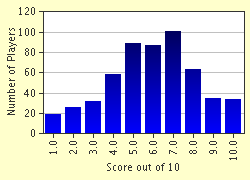Quiz Answer Key and Fun Facts
1. Which of the following is not one of the salivary glands?
2. Saliva is one of the strongest acidic fluids of the body, containing enzymes that aid in the digestion of some foods.
3. To differentiate human enzymes from hormones which of the following is primarily true?
4. Which of these does not produce digestive enzymes?
5. The enzyme called lipase is a catalyst for the metabolism of which of these foods?
6. The enzyme called peptidase is a catalyst for the metabolism of which of these foods?
7. The enzyme named ptyalin is a catalyst for the metabolism of which of these food?
8. Which artificially produced digestive enzyme is used in the treatment of patients with cystic fibrosis?
9. Which artifically produced enzyme-inhibitor is used for the treatment of patients who are HIV positive (the virus that causes AIDS)?
10. Which of these is not an enzyme, natural or artificial, that is used for medicinal or research purposes?
Source: Author
YOMD39
This quiz was reviewed by FunTrivia editor
rossian before going online.
Any errors found in FunTrivia content are routinely corrected through our feedback system.

